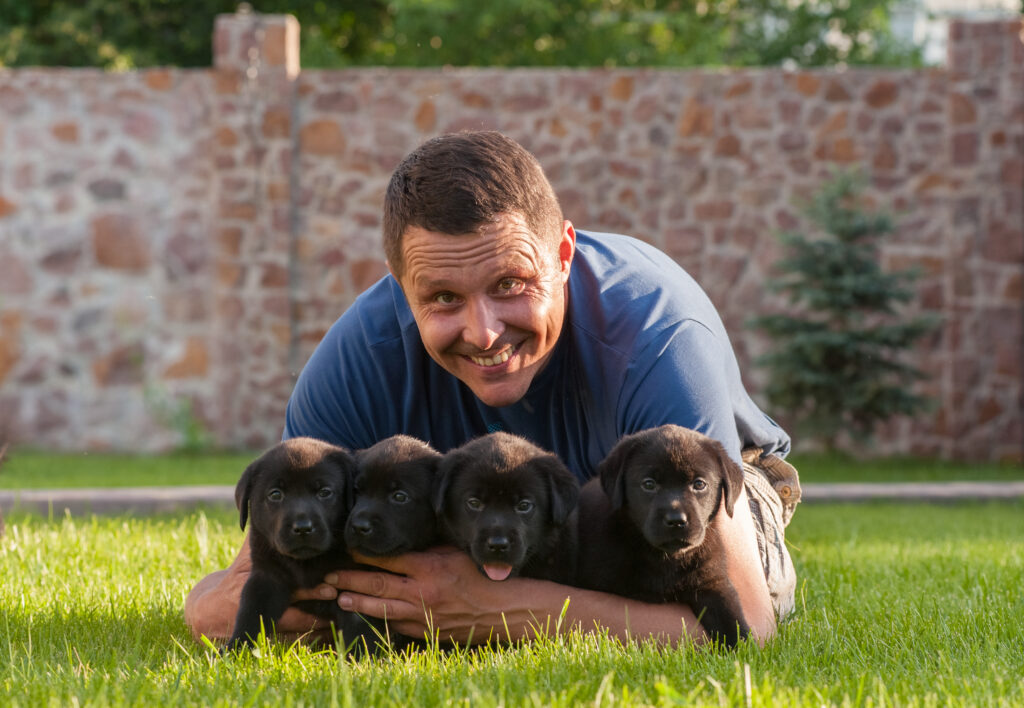It’s not always easy to predict how a puppy will behave as an adult, but some signs can give insight into whether a puppy is likely to grow into a calm and well-balanced dog.
Here are some key ways to assess a puppy’s temperament…
Observe Behavior with Littermates
- Balanced Play – Look for a puppy that plays but isn’t overly dominant or aggressive. Puppies that engage moderately, without being too timid or wild, often grow into calm dogs.
- Self-Regulation – A puppy that knows when to take breaks from play and lies down on their own shows signs of good emotional regulation.
Assess Response to New Situations
- Curious but Not Fearful – A puppy that approaches new objects, people, or sounds with curiosity but not hyperactivity or fear is more likely to be calm.
- Low Startle Response – When exposed to a sudden noise or unexpected event, a calm puppy may startle briefly but recover quickly instead of panicking or overexciting.
Try Some Simple Temperament Tests
- Cradle Test – Gently hold the puppy on their back in your arms. A relaxed puppy that tolerates this position without panicking or wriggling excessively is likely to be calmer as an adult.
- Follow Test – Walk a few steps away from the puppy. A calm, well-balanced puppy will follow with interest but not in a frantic or clingy manner.
- Noise Reaction Test – Clap your hands or make a soft noise. A puppy with a calm temperament might look toward the source of the noise but won’t bark, growl, or get overly excited.
Look for Comfort with Handling
- Tolerates Touch – Puppies that remain calm when you touch their ears, paws, and tail are likely to grow into dogs that are comfortable being handled.
- Relaxed Posture – A puppy that isn’t stiff or tense when picked up or cuddled shows signs of having a calm disposition.
Observe How the Puppy Responds to Separation
- Moderate Independence – A puppy that can explore on their own but still checks in with you occasionally tends to have a balanced personality.
- No Extreme Anxiety – Avoid puppies that show extreme distress when left alone briefly, as this could indicate separation anxiety tendencies.
Check the Parents’ Temperament
- Calm Parents = Calm Puppy – If the puppy’s parents (especially the mother) are calm and friendly, there is a higher chance the puppy will have similar traits. Temperament can be hereditary.
Consider the Puppy’s Breed
- Breed Traits – Some breeds are naturally more calm than others. For example, breeds like the Golden Retriever, Labrador Retriever, and Basset Hound are generally more easygoing, while working breeds like Border Collies and Huskies may have higher energy.
Monitor for Excessive Behavior
- Red Flags – Be cautious of puppies that exhibit constant nipping, barking, or restlessness. These could be signs of hyperactivity or behavioral issues that may continue into adulthood.
Watch for Ability to Relax
- Settles Quickly – A puppy that can settle down and relax after playtime shows good emotional regulation, which is a sign of a calm adult dog.
While no method can guarantee how a puppy will behave as an adult, puppies that show curiosity without fear, tolerate handling, engage in play without excessive aggression, and take breaks to rest are more likely to grow into calm, well-adjusted dogs. Additionally, a puppy’s temperament will continue to develop with proper training, socialization, and care from their new family.


